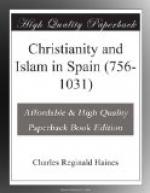Besides these two isolated cases of martyrdom, we do not find any more recorded until the reign of Abdurrahman ii. (May 822-Aug. 852). In the second year of this king’s reign, two Christians, John and Adulphus, making public profession of their faith, and denouncing Mohammed, were put to death on Sept 17, 824.[2]
[1] We give the account as
Fleury, v. 88 (Bk. 42), gives it,
but with great doubts as to
its genuineness, no other writer
that we have seen mentioning
it.
[2] Florez, x. 358: Fleury,
v. 487. They were buried in St
Cyprian’s Church, Cordova.
See “De translatione martyrum
Georgii etc.,”
sec. 7.
This is the first definite indication we have that the toleration shown by the Moslems was beginning to be abused by their Christian subjects; and there can be no reasonable doubt that this ill-advised conduct on the part of the latter was the main cause of the so-called persecution which followed. But besides this fanaticism on the part of a small section of the subject Christians, there were other causes at work calculated to produce friction between the two peoples. During the century which had elapsed since the conquest, the Christians and Mohammedans, living side by side under the same government, and one which, considering the times in which it arose, was remarkable no less for its equity and moderation than for its external splendour and magnificence, had gradually been drawn closer together. Intermarriages had become frequent among them;[1] and these proved the fruitful cause of religious dissensions. Accordingly we find that the religious troubles in the reigns of Abdurrahman ii. (822-852) and Mohammed I. (852-886) began with the execution of two children of mixed parents. Nunilo and Alodia were the children of a Moslem father and a Christian mother. Their father was a tolerant man, and, apparently, while he lived, permitted his children to profess the faith of their mother. On his death, the mother married again, and the new husband, being a bigoted Mohammedan, and actuated, as we may suppose, by the odio vitrici, immediately set about reclaiming his step-children to the true faith of Islam, his efforts in this direction leading him to ill-treat, even to torture,[2] the young confessors. His utmost endeavour to effect their conversion failing, he delivered them over to the judge on the charge of apostasy, and the judge to the executioner, by whom they were beheaded on Oct. 21, 840.[3]




